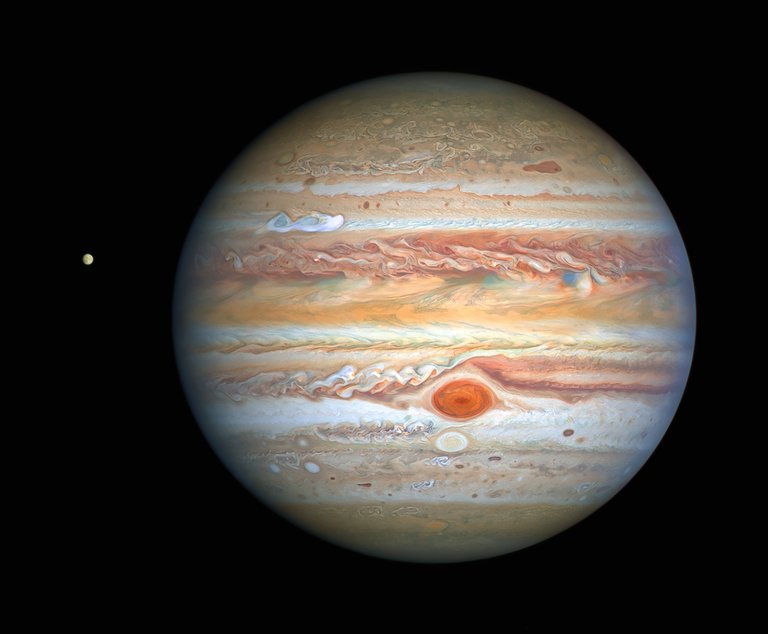They clarify the origin, age and evolution of the Great Red Spot of Jupiter

Historical observations of the Great Red Spot of Jupiter have been analyzed since the 17th century and numerical models have been developed to explain the genesis, nature and evolution of this meteorological phenomenon. In this work, researchers from the University of the Basque Country, the Polytechnic University of Catalonia, BarcelonaTech (UPC) and the Barcelona Supercomputing Center (CNS-BSC) have collaborated, who have published their results in the journal Geophysical Research Letters of the American Geophysical Union.
According to the article, Jupiter's Great Red Spot is probably the most known atmospheric structure outside the Earth. In fact, its large size (today the diameter of the Earth) and its reddish color make it easily visible, even with small telescopes. The Great Red Spot of Jupiter is a large anti-cyclonic swirl that circulates on its periphery at a speed of 450 km/h. It is the largest and most neglected whirlpool of the atmospheres of the planets of the Solar System, but its age and genesis are the subject of discussion.
The first studies of the Great Red Spot are due to astronomer Giovanni Domenico Cassini. In 1665 he found a dark oval in the same latitude as the Great Red Spot and called it the Permanent Spot. It was observed until 1713 and was later lost its mark for 118 years. In 1831 and following years S. Schwabe saw a clear structure, approximately oval and at the same latitude as the Great Red Spot. It can be considered as the first observation of the current Great Red Spot.
In the present study, the authors have analyzed, on the one hand, the evolution of size over time, its structure and the movements of the two meteorological formations, resorting to historical sources from the mid-17th century, to sources little known from the invention of the telescope. From the measurements of size and movements it follows that it is very unlikely that the current Great Red Spot will be a Permanent Spot seen by Cassini. Probably, the Permanent Spot once disappeared in the mid-eighteenth and nineteenth centuries; thus, the head of research, Agustín Sánchez Lavega, explains that the Red Spot, for the time being, has more than 190 years of life. The Red Spot, which in 1879 was 39,000 km in its longest axis, has been contracted and rounded up to 14,000 km today.
On the other hand, since the 1970s, several space missions have closely analyzed this meteorological phenomenon. Recently, the instruments of the Juno mission in orbit around Jupiter have shown that the Great Yellow Spot is not very deep (about 500 km).
To learn how this terrible whirlpool emerged, the teams of the UPV/EHU and the UPC have carried out numerical simulations on Spanish supercomputers, such as the BSC’s CyprusNostrum IV, integrated into the Spanish Supercomputing Network (RES), through two complementary models of the behavior of the whirlwinds in the atmosphere of Jupiter. On the giant planet prevail the intense wind currents that run through the parallels alternating in their direction with latitude. North of the Great Red Spot, the wind blows to the west at a speed of 180 km/h, while south strikes the other way east at a speed of 150 km/h. This creates a large shear from north to south at wind speed, a fundamental component for the growth of the whirlpool in its interior.
The study analyzed several mechanisms to explain its genesis, such as the eruption of a gigantic superstorm, very similar to those observed intermittently on the twin planet Saturn, or the fusion of many of the small eddies created by the wind shear. The results indicate that, although an anticyclone is formed in both cases, it does not correspond to the dynamic shape and properties of the current Great Red Spot.
In another group of numerical experiments, the study of formation is part of a known instability of winds. They consider that this instability is capable of creating an elongated cell that would be a proto blot, a forming Red Blot. Its contraction would provoke the dense and rapid revolving Great Red Spot seen at the end of the 19th century. The formation of large elongated cells has been seen in the formation of other important eddies of Jupiter. Using two numerical models, one in the UPV/EHU and the other in the UPC, researchers have concluded that if the rotation velocity of the proto spot is lower than that of the surrounding winds, it is divided and it is impossible to create a stable whirlpool. And if it's very high, its properties don't match the characteristics of the current Great Red Spot.
The objective of future research will be to try to reproduce the contraction of the Great Red Spot in time to learn more about the physical mechanisms underlying its maintenance over time. At the same time, they will try to predict whether the Great Red Spot will disintegrate and disappear, when it reaches a limit size, as could happen with the Cassini Permanent Spot, or whether it will stabilize at a limit size in which it can stay for long years.
Buletina
Bidali zure helbide elektronikoa eta jaso asteroko buletina zure sarrera-ontzian











